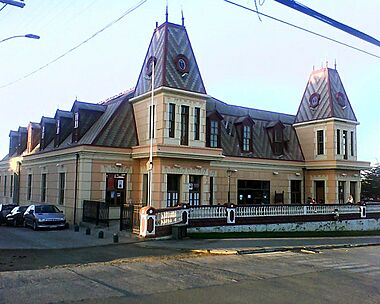List of National Monuments of Chile facts for kids
The National Monuments of Chile are special places, buildings, and objects that are legally protected because they are important parts of Chile's history, art, or science. Think of them as treasures that show us about the country's past and culture. They are also called MN for short.
Contents
What Are National Monuments?
A law in Chile (Law N° 17.288) explains what a National Monument is. It says they can be places, old ruins, buildings, or objects that have historical or artistic value. This also includes old burial sites, things left by ancient people, or natural formations. If something is important for history, art, or science, and the government wants to protect it, it can be declared a National Monument. This also includes statues, fountains, and other items placed in public areas to remember something important.
As of 2008, Chile had 938 National Monuments. They are sorted into different groups:
- Historic Monuments (633)
- Public Monuments (150)
- Archaeological Monuments (21)
- Typical or Picturesque Zones (95)
- Nature Sanctuaries (39)
Historic Monuments
Historic Monuments are places, ruins, buildings, and objects that are very old or have a lot of historical or artistic importance. The government officially declares them as such to make sure they are preserved.
In 2008, there were 633 Historic Monuments. Some examples include:
- Agustín Ross Cultural Centre: A beautiful old building in Pichilemu.
- Cerro Santa Lucía: A famous hill in Santiago with gardens and historical features.
- Chivilingo Hydroelectric Plant: One of the first hydroelectric power plants in Chile.
- Humberstone and Santa Laura Saltpeter Works: Old industrial sites in the desert that show how saltpeter was mined.
- Iglesias de Chiloé: Many unique wooden churches on the Chiloé islands.
- La Moneda Palace: The official seat of the President of Chile in Santiago.
- Morro de Arica: A historic hill in Arica, important for its role in a battle.
- National Library of Chile: A large library in Santiago that holds many important books and documents.
- Sewell, Chile: An old mining town built on a mountain slope.
- Trolleybus system of Valparaíso: An old electric bus system still running in Valparaíso.
- Wulff Castle: A unique castle-like building on the coast in Viña del Mar.
Public Monuments
Public Monuments are objects that are placed in public areas to remember something or someone important. These can be statues, columns, or plaques. The National Monuments Council keeps a list of these. In 2008, there were 150 public monuments listed. An example is the Hito al Trópico de Capricornio, which marks the Tropic of Capricorn line.
Archaeological Monuments
Archaeological Monuments are places, ruins, or objects that show us about ancient human life. These can be found underground, on the surface, or even underwater. They are important for studying history and how people lived long ago.
In 2008, there were 21 archaeological monuments. Some of them are:
- Monte Verde: A very old archaeological site that shows human presence from thousands of years ago.
- Pukará de Quitor: An ancient fortress built by indigenous people in the Atacama Desert.
- Tulor: An old village site with circular houses, also in the Atacama Desert.
Typical or Picturesque Zones
These are areas, either in cities or the countryside, that have a special look or feel. They might have unique building styles, materials, or construction methods. They are protected to keep their special character, especially if they have historical buildings or archaeological ruins.
In 2008, there were 95 typical zones. Some examples include:
- Angelmó: A famous market and fishing port in Puerto Montt.
- Barrio París-Londres: A charming neighborhood in Santiago with European-style streets.
- Cajón del Maipo: A beautiful natural area near Santiago with mountains and rivers.
- Historic centre of Iquique: The old part of Iquique city with unique architecture.
- Pichilemu: A coastal town known for its surf and historic buildings.
- Plaza de Armas, Former National Congress of Chile building, and nearby buildings, Santiago: The main square and important historical buildings in the heart of Santiago.
- Sewell, Chile: The former mining town, also listed as a Historic Monument.
- Viaducto del Malleco: An impressive old railway bridge.
Nature Sanctuaries

Nature Sanctuaries are special places on land or in the sea that are great for studying geology, animals, plants, or the environment. They might also have unique natural formations. These areas are protected because they are important for science or for the country's natural heritage.
Chile has designated 39 nature sanctuaries to protect these important natural areas.
See also
 In Spanish: Monumentos nacionales de Chile para niños
In Spanish: Monumentos nacionales de Chile para niños
- List of National Monuments of Chile by region


